FRIDAY, DECEMBER 2
■ Orion clears the eastern horizon by about 7:30 p.m. now, depending on how far east or west you live in your time zone. His two brightest stars are Betelgeuse on the left and white Rigel on the right. Orion's three-star belt is between them, almost vertical.
Orion's tilt when rising depends on your latitude. If you live north of 33° N (Los Angeles, Atlanta, the Nile delta, Shanghai), Betelgeuse will be higher than Rigel just after they rise. If you're south of 33°, Rigel will be the higher one; Orion comes up foot first.
As the night goes on, however, Betelgeuse always gain the upper position — as seen from anywhere in the Northern Hemisphere.
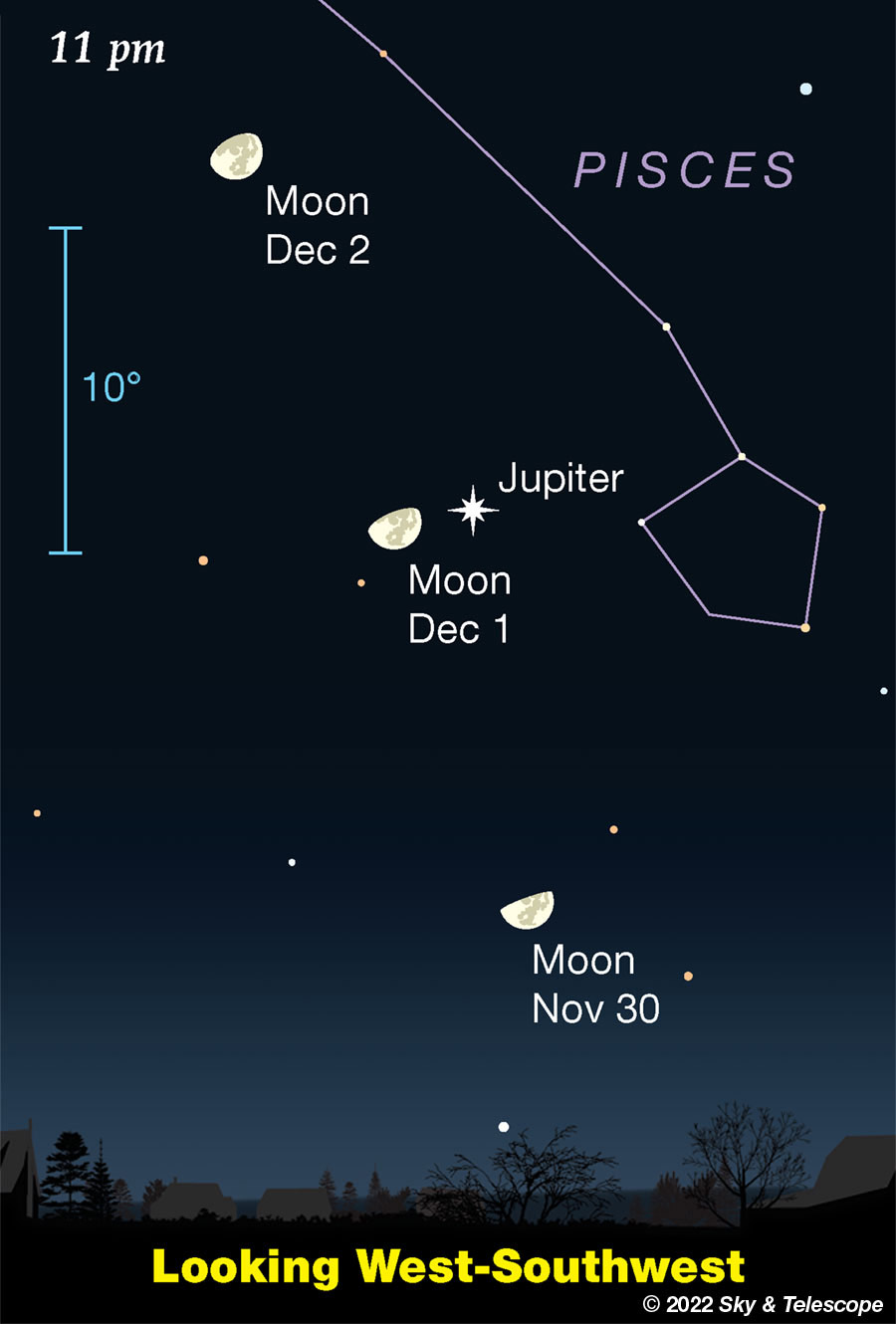
■ A small telescope will show much more about lunar geology than just craters, plains and mountains. As the terminator now unveils more of the waxing gibbous Moon, get out your lunar map to use with Chuck Wood's "Layer Upon Layer Upon Layer" article in his Exploring the Moon column and photos, December Sky & Telescope, page 52. "Follow the clues leading back to the formation of two large lunar basins." You may have seen these clues in your scope but not recognized what they are!
SATURDAY, DECEMBER 3
■ Vega still shines brightly well up in the west-northwest after dark. The brightest star above it is Deneb, the head of the big Northern Cross, formed by the brightest stars of Cygnus. At nightfall the shaft of the cross extends lower left from Deneb. By 10 or 11 p.m. it plants itself more or less upright on the northwest horizon.
SUNDAY, DECEMBER 4
■ Jupiter's Great Red Spot should transit the planet's central meridian around 9:52 p.m. EST; 6:52 p.m. PST. A light blue or green filter at the eyepiece helps a bit.
MONDAY, DECEMBER 5
■ Once Orion climbs up in the east-southeast after dinnertime (far lower left of the Moon tonight), look for Gemini also gaining altitude to Orion's left (as seen from mid-northern latitudes). The head stars of the Gemini twins, Castor and Pollux, are at the left end of the Gemini constellation — one over the other, with Castor on top. The stick-figure Twins are lying on their side.
TUESDAY, DECEMBER 6
■ At this time of year the Big Dipper lies shyly down lowest soon after dark, due north. It's entirely below the north horizon if you're as far south as Miami.
But by midnight the Dipper stands straight up on its handle in fine view in the northeast — while Cassiopeia has wheeled down to the northwest to stand nearly upright, on the bright end of its W shape.
WEDNESDAY, DECEMBER 7
■ The full Moon and full Mars shine together tonight; both are at opposition! Moreover, the Moon occults Mars for most of North America and Europe.
The Moon is exactly full at 11:08 p.m. EST (4:08 December 8th UT). Mars is exactly at opposition less than two hours later. Mars is still a big 17.2 arcseconds wide a week after its closest approach to Earth, and brilliant at magnitude –1.8. It far outshines the stars of its background constellation, Taurus.
The scene below is rather generic; where you will actually see Mars with respect to the Moon tonight depends on the time and your location.
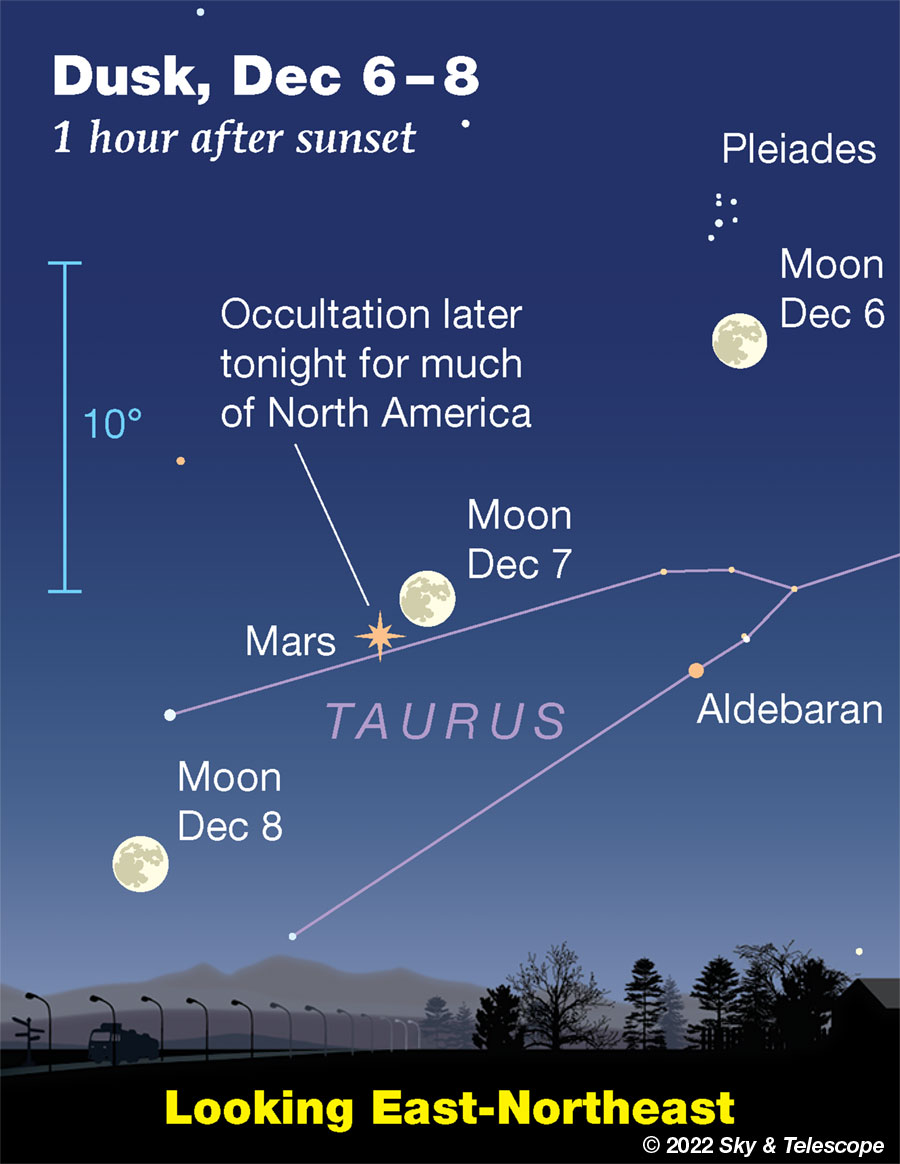
The Moon and Mars are currently 2° north of the opposition point on the ecliptic, which is why Earth's shadow misses the Moon and we don't get a lunar eclipse. Similarly, if you were standing on Mars, the Earth would not quite transit the Sun.
In fact the full Moon passes in front of Mars, hiding it for up to an hour or more, if you're in the occultation zone on this world map. Outside the zone you'll see a near miss. Writes Bob King in Mars Mesmerizes at December Opposition,
As the time of occultation approaches, the Moon will edge its way toward Mars and then slowly devour the Red Planet, taking many seconds to completely cover it. Depending on your location, Mars will go missing for minutes to more than an hour until it returns to view at the opposite limb, making for an equally astounding sight.
Even as bright as Mars is, though, you'll want to use a telescope at fairly high power. To the naked eye, the glare of the Moon's brilliant limb will hide Mars from view a little before and a little after the occultation — right when the action happens!
When will Mars disappear and reappear for your location? Use the timetables here. The first two tables are very long: the first gives the time of Mars's disappearance; the second its reappearance out from behind the Moon, for many locations. Scroll to be sure you're using the right table; watch for the new heading as you scroll down. The first two letters in each entry are the country abbreviation ("CA" is Canada, not California). The times are in UT (GMT) December 8th; UT is 5 hours ahead of Eastern Standard Time, 6 ahead of CST, 7 ahead of MST, and 8 ahead of PST.
For instance: Use the tables to see that for Los Angeles, Mars disappears at 6:30 p.m. PST when the Moon is 22° above the horizon, then reappears at 7:30 p.m. PST when the Moon is 35° high.
A livestream of the occultation and Mars opposition starts at 4:00 Dec. 8 UT (11:00 p.m. Dec. 7 EST), courtesy of the Virtual Telescope Project.
■ Earliest sunset of the year today, if you're near latitude 40° north. By the time of the solstice and longest night on December 21st, the Sun actually sets 3 minutes later than it does now. And the latest sunrise doesn't come until January 4th. These slight discrepancies arise from the tilt of Earth's axis and the ellipticity of Earth's orbit.
THURSDAY, DECEMBER 8
■ The Summer Triangle sinks lower in the west as evening proceeds, and Altair is the first of its stars to go (for mid-northern skywatchers). Start by spotting bright Vega, magnitude zero, the brightest star in the northwest soon after dark. The brightest one above Vega is Deneb. Altair, the Triangle's third star, is farther to Vega's left. How late into the night, and into the advancing season, can you keep Altair in view?
FRIDAY, DECEMBER 9
■ Now Orion is clearing the eastern horizon as early as 7 p.m. (depending on how far east or west you live in your time zone). One week later means the stars reach any given position in the sky a half hour earlier.
■ The waning gibbous Moon this evening forms a big, nearly equilateral triangle with Mars high to its upper right and Capella high above the Moon.
SATURDAY, DECEMBER 10
■ The waning gibbous Moon rises in late twilight. Once the stars come out, spot Pollux just to the Moon's left. Above Pollux is Castor.
This Week's Planet Roundup
Mercury and Venus are deep in the bright glow of sunset. Try with binoculars about 20 minutes after sundown; look just barely above the southwest horizon. Venus is by far the brighter of the two, at magnitude –3.9. Mercury, a few degrees to Venus's left, is about mag –0.6 and probably invisible. They'll both get a little easier day by day. When can you first pick them both up?
Mars, magnitude –1.8, blazes low in the east-northeast as the stars begin to come out, then gains altitude until culminating nearly overhead around midnight. There's no missing it; Mars outshines even Sirius (which rises around 8 or 9 p.m.). Mars's fiery yellow-orange color always helps give it away. In a telescope Mars is 17 arcseconds wide, still the biggest we'll see it until 2033. But it's about to shrink.
In the early evening hours, look for Mars-colored Aldebaran about 10° to Mars's right. Look for Mars-colored Betelgeuse a little more than twice as far below the planet.
Mars is at opposition the night of December 7-8 — when the full Moon will occult it for much of North America and Western Europe. See the entry for December 7 above. Also see Bob King's Mars Mesmerizes at December Opposition, which includes telescopic maps to identify Martian surface markings all this season. See too the December Sky & Telescope, page 49, which also includes a table of the near-miss times and separations for cities in the eastern U.S. outside the occultation zone.
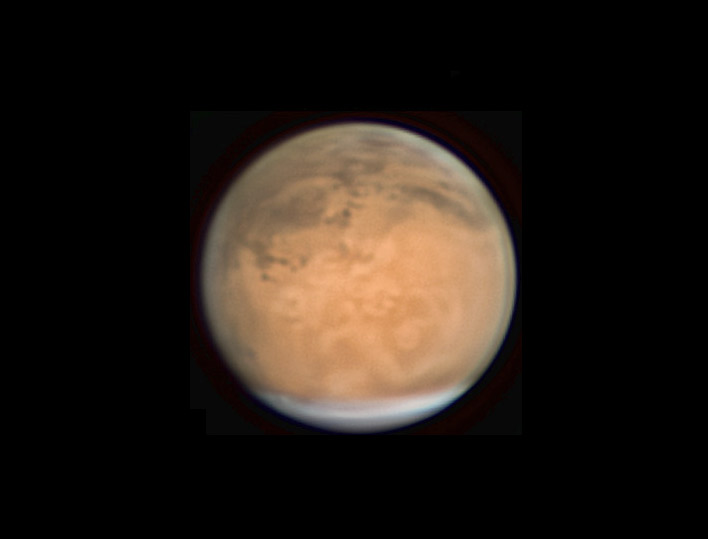
South in the image is up. Solis Lacus, "the eye of Mars," is the roundish dark patch at upper left nearly surrounded by a brighter ring. The faint round pattern at lower right betrays Olympus Mons. Tharsis is a section of the large bright area. "The north polar cloud hood is thinning out," writes Go. "We should see the north polar cap soon."
Jupiter blazes white high in the south through early evening. At magnitude –2.6 it vastly outshines the stars in dim Pisces. It's highest in the south soon after dark. Look for the Great Square of Pegasus above Jupiter in early evening, and upper right of Jupiter later in the evening. Telescopically, Jupiter is down to about 42 arcseconds wide.
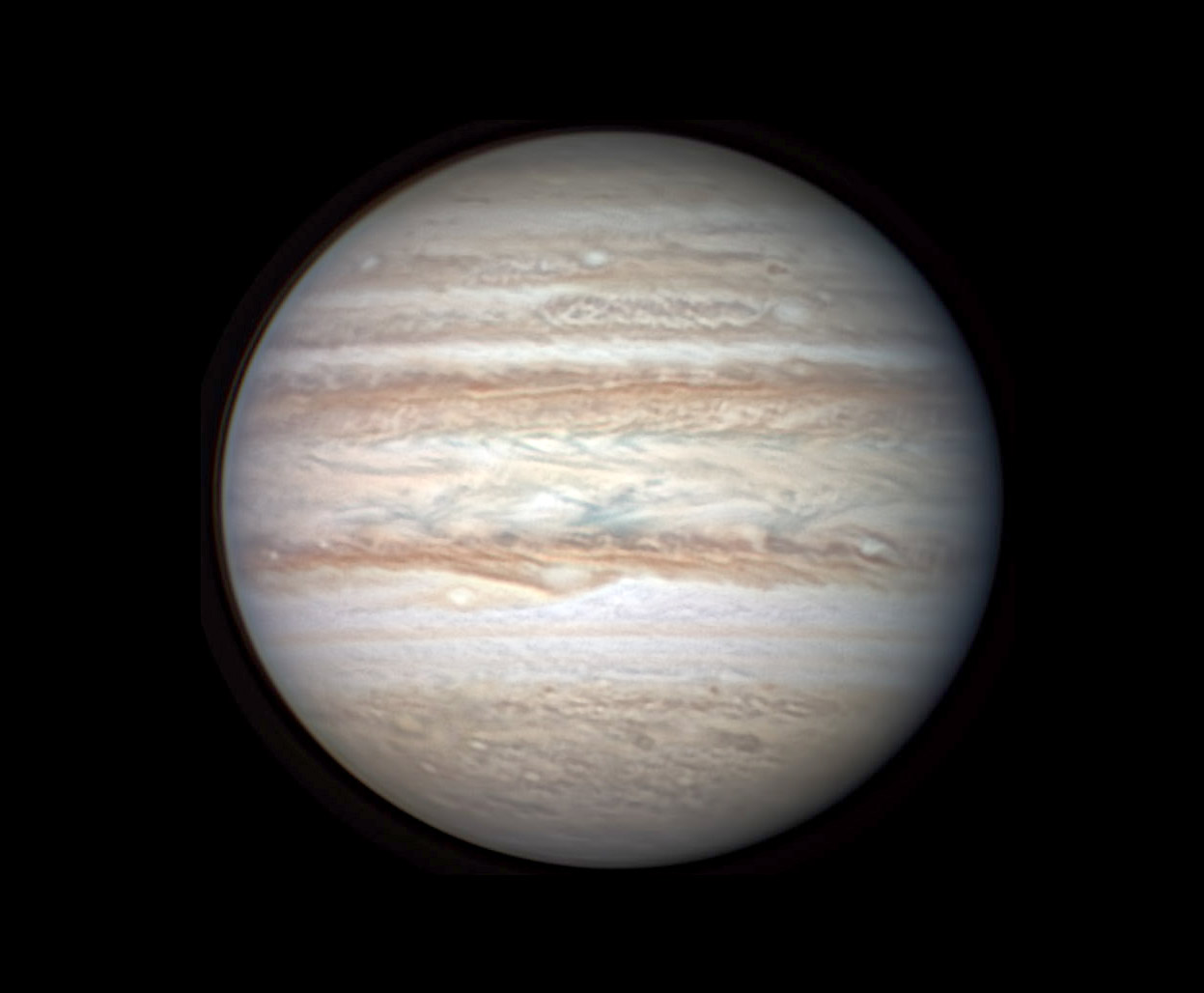
Here on the non-Red-Spot side of Jupiter, notice the big, brownish arch hanging down from the North Equatorial Belt. This high-resolution image shows that the arch surrounds a gray oval. Visually, even with a telescope this big, all you may be able to see of the arch is an unusual bump on the belt's north side. More such arches have appeared on the other side of the planet. From the NEB's south side, blue festoons trail into the Equatorial Zone. Bluish areas are gaps in the clouds, allowing us to see deeper down through the blue-sky hydrogen air.
Saturn, magnitude +0.8 in Capricornus, glows in the southwest as twilight fades. Left of it, by two fists or more, sparkles fainter Fomalhaut. As night progresses, Saturn moves lower and sets around 9 or 10 p.m.
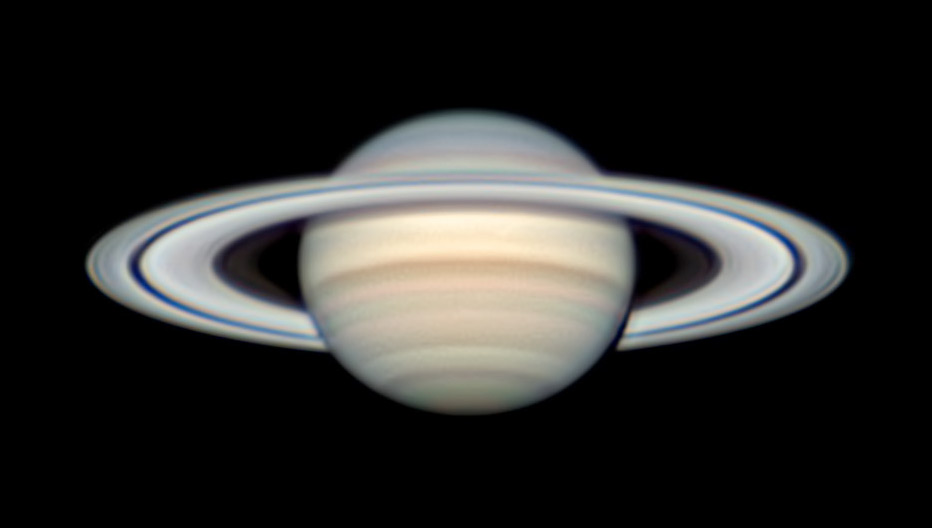

Uranus, magnitude 5.7 in Aries, is high in the southeast in early evening. It displays a tiny, very slightly blue-greenish gray disk 3.7 arcseconds wide. It a telescope at high power it's obviously non-stellar. See the Uranus finder charts in the November Sky & Telescope, page 49.
Neptune, magnitude 7.9 at the Aquarius-Pisces border, is high in early evening about 6° west of Jupiter. It's just 2.3 arcseconds wide, again non-stellar in a telescope but requiring more effort than Uranus. It's slightly bluish gray, if you have enough aperture to show color at all in something this faint. See the Neptune finder charts in the September Sky & Telescope, page 49.
All descriptions that relate to your horizon — including the words up, down, right, and left — are written for the world's mid-northern latitudes. Descriptions and graphics that also depend on longitude (mainly Moon positions) are for North America.
Eastern Standard Time (EST) is Universal Time minus 5 hours. Universal Time is also called UT, UTC, GMT or Z time.
Want to become a better astronomer? Learn your way around the constellations. They're the key to locating everything fainter and deeper to hunt with binoculars or a telescope.
This is an outdoor nature hobby. For an easy-to-use constellation guide covering the whole evening sky, use the big monthly map in the center of each issue of Sky & Telescope, the essential magazine of astronomy.
Once you get a telescope, to put it to good use you'll need a detailed, large-scale sky atlas (set of charts). The basic standard is the Pocket Sky Atlas (in either the original or Jumbo Edition), which shows stars to magnitude 7.6.

Next up is the larger and deeper Sky Atlas 2000.0, plotting stars to magnitude 8.5; nearly three times as many. The next up, once you know your way around, are the even larger Interstellarum atlas (stars to magnitude 9.5) or Uranometria 2000.0 (stars to magnitude 9.75). And be sure to read How to Use a Star Chart with a Telescope. It applies just as much to charts on your phone or tablet as to charts on paper.
You'll also want a good deep-sky guidebook. A beloved old classic is the three-volume Burnham's Celestial Handbook. An impressive more modern one is the big Night Sky Observer's Guide set (2+ volumes) by Kepple and Sanner.
Can a computerized telescope replace charts? Not for beginners, I don't think, and not on mounts and tripods that are less than top-quality mechanically, meaning heavy and expensive. And as Terence Dickinson and Alan Dyer say in their Backyard Astronomer's Guide, "A full appreciation of the universe cannot come without developing the skills to find things in the sky and understanding how the sky works. This knowledge comes only by spending time under the stars with star maps in hand."
![]() Audio sky tour. Out under the evening sky with your
Audio sky tour. Out under the evening sky with your
earbuds in place, listen to Kelly Beatty's monthly
podcast tour of the heavens above. It's free.
"The dangers of not thinking clearly are much greater now than ever before. It's not that there's something new in our way of thinking, it's that credulous and confused thinking can be much more lethal in ways it was never before."
— Carl Sagan, 1996
"Facts are stubborn things."
— John Adams, 1770
 7
7









Comments
Tony
December 3, 2022 at 11:17 am
In 1975 the Dominion Astrophysical Observatory near Victoria BC treated visitors to a view of Uranus through one of its giant telescopes, either the 1,220 mm Grubb Parsons (1962) or the 1,850 mm Plaskett (1918). The planet's apparent size was close to that of the full Moon, and it was a beautiful blue-green with no grayish pallor. Neptune was somewhat close by, but farther south . . . already "digging coal" from the Observatory's view.
You must be logged in to post a comment.
Rod
December 4, 2022 at 9:36 pm
I was able to observe Mars tonight. [Observed 1900-2030 EST/0000-0130 UT 05-Dec-2022. Waxing gibbous Moon in Aries. Full Moon 08-Dec-2022 0408 UT/2308 EST 07-Dec-2022. Some excellent Mars observing this evening using my 10-inch Newtonian on Dob mount from 86x to 214x with Celestron #23A red filter. After tweaking the collimation last week, I enjoyed some very sharp images of Mars tonight. I used TeleVue 14-mm Delos with TeleVue 1.8x and 2.5x Barlow lenses. The Mars Profiler tool at Sky & Telescope website showed the central meridian longitude was 193 degrees at 1900 EST and 215 degrees at 2030 EST. Some very distinct surface features visible, especially at 154x and 214x tonight. Mars about 0.546 au distance and at 214x I could see to about 1.4 arcsecond angular resolution. On Mars that is an area of about 554 km diameter. While looking at Mars tonight, some great horn owls began hooting and some foxes out hunting fox barked. Moonlight over the fields and woods and shadows of the trees lovely. The waxing gibbous Moon was bright. This was a very enjoyable Mars time as the planet approaches opposition. Clear skies and temperature -2C with light wind or calm.
You must be logged in to post a comment.
New Jersey Eclipse Fan
December 5, 2022 at 9:22 pm
Great report! Just one question: Do foxes really hunt fox--and bark, too? 😉
You must be logged in to post a comment.
Rod
December 6, 2022 at 6:47 am
Lol! Foxes are out at night; some get excited and started their fox calls. One recently was doing that fox bark at me, about 200 hundreds from a large chicken coop nearby where I was observing from. I used my red light and that critter had angry red eyes glaring at me 🙂 Weather for this Wednesday close encounter with the Moon and Mars looks terrible at my location in MD now. Light rain here this morning. New Jersey Eclipse Fan, I run with Big Foot and the wolf pack too 🙂
You must be logged in to post a comment.
TomR
December 6, 2022 at 6:34 am
Thank you for mentioning quadrature!
To my imagination this happens, when “we” pass one of the tangent-points, we can construct from an outer planet to the path of planet earth?
Earth should then appear half-lit seen from an outer planet, and the outer planet should begin / stop its retrograde motion??
You must be logged in to post a comment.
cyrtonyx
December 7, 2022 at 1:29 pm
From the point of view of an outer planet ( Mars, for instance) Earth would then be a 'morning' or 'evening' apparition then?
You must be logged in to post a comment.
Rod
December 7, 2022 at 10:57 pm
https://skyandtelescope.org/astronomy-news/mars-mesmerizes-at-december-8th-opposition/#comment-385710
My observation notes at Bob King report page. Overcast and soup tonight for me but using 10x50 binoculars, I did see the Moon and Mars getting kissing close but only brief views 🙂
You must be logged in to post a comment.
You must be logged in to post a comment.